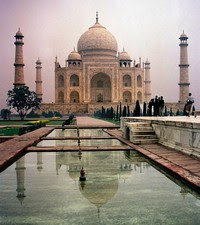 Agra (Hindi: आगरा, Urdu: آگرا) is a city on the banks of the Yamuna River in the northern state of Uttar Pradesh, India. It finds mention in the epic Mahabharata when it was called Agrabana, or Paradise. Ptolemy, the famous 2nd century geographer, marked it on his map of the world as Agra. Tradition and legend ascribe the present city of Raja Badal Singh (around 1475) whose Fort, Badalgarh, Stood on or near the site of the present Fort. However, the 12th century Persian poet Salman writes of a desperate assault on the fortress of Agra, then held by one King Jaipal, by Sultan Mahmud of Ghazni. It was ruled by Sultan Sikandar Lodi in the year 1506. It achieved fame as the capital of the Mughal emperors from 1526 to 1658 and remains a major tourist destination because of its many splendid Mughal-era buildings, most notably the Taj Mahal, Agra Fort and Fatehpur Sikri, all three of which are UNESCO World Heritage Sites.
Agra (Hindi: आगरा, Urdu: آگرا) is a city on the banks of the Yamuna River in the northern state of Uttar Pradesh, India. It finds mention in the epic Mahabharata when it was called Agrabana, or Paradise. Ptolemy, the famous 2nd century geographer, marked it on his map of the world as Agra. Tradition and legend ascribe the present city of Raja Badal Singh (around 1475) whose Fort, Badalgarh, Stood on or near the site of the present Fort. However, the 12th century Persian poet Salman writes of a desperate assault on the fortress of Agra, then held by one King Jaipal, by Sultan Mahmud of Ghazni. It was ruled by Sultan Sikandar Lodi in the year 1506. It achieved fame as the capital of the Mughal emperors from 1526 to 1658 and remains a major tourist destination because of its many splendid Mughal-era buildings, most notably the Taj Mahal, Agra Fort and Fatehpur Sikri, all three of which are UNESCO World Heritage Sites.
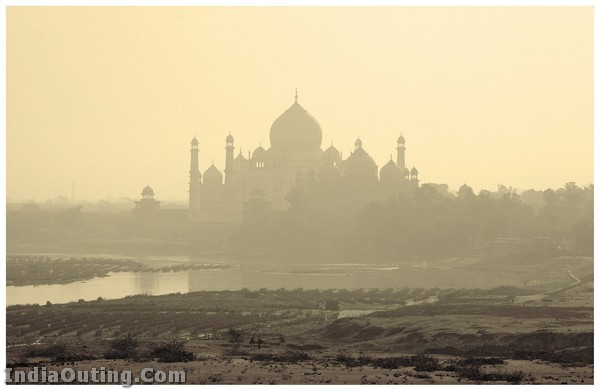
History
Agra is a medieval city situated on the banks of the river Yamuna. It is generally accepted that Sultan Sikandar Lodi, the Ruler of Delhi Sultanate founded it in the year 1504. After the sultan’s death the city passed on to his son Sultan Ibrahim Lodi. He ruled his Sultanate from Agra until he fell fighting to Babur in the First battle of Panipat fought in 1526.
In the year 1556, the great Hindu warrior, Hemu Vikramaditya also known as Hem Chander Vikramaditya won Agra as Prime Minister cum Chief of Army of Adil Shah of Afgan Sur Dynasty. The commander of Humayun / Akbar’s forces in Agra was so scared of Hemu that he ran away from Agra without the fight. This was Hemu’s 21st continuous win, who later on won Delhi also and had his coronation at Purana Qila in Delhi and re-established his Kingdom and the Vikramaditya Dynasty in North India.
The golden age of the city began with the Mughals. It was known then as Akbarabad and remained the capital of the Mughal Empire under Emperor Akbar, Jahangir and Shah Jahan. Shah Jahan later shifted his capital to Shahjahanabad in the year 1649.
Since Akbarabad was one of the most important cities in India under the Mughals, it witnessed a lot of building activity. Babar, the founder of the Mughal dynasty laid out the first formal Persian garden on the banks of river Yamuna. The garden is called the Aram Bagh or the Garden of Relaxation. His grandson Akbar raised the towering ramparts of the Great Red Fort besides making Agra, a center for learning arts, commerce and religion. Akbar also built a new city on the outskirts of Akbarabad called Fatehpur Sikri. This city was built in the form of a Mughal military camp in stone.
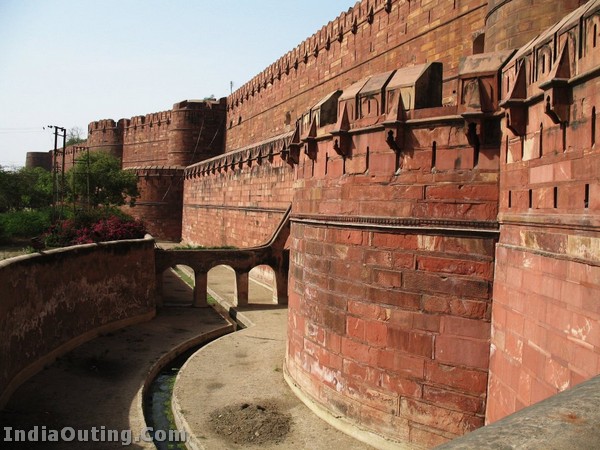
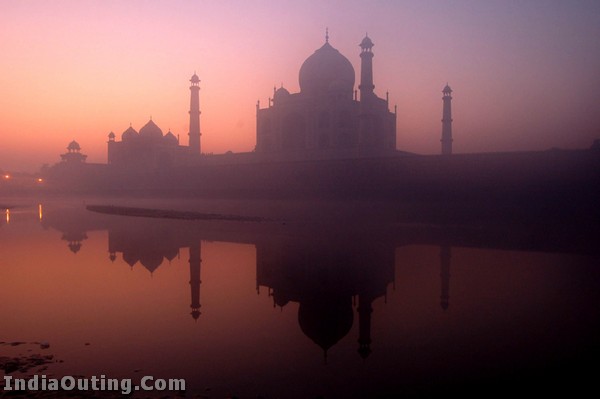
His son Jahangir had a love of gardens and flora and fauna and laid many gardens inside the Red Fort or Laal Kila. Shah Jahan known for his keen interest in architecture gave Akbarabad its most prized monument, The Taj Mahal. Built in loving memory of his wife Mumtaz Mahal, the mausoleum was completed in 1653.
Shah Jahan later shifted the capital to Delhi during his reign, but this son Aurangzeb shifted the capital back to Akbarabad and had his father imprisoned in the Fort there. Akbarabad remained capital of India during the rule of Aurangzeb until he shifted it to Aurangabad in the Deccan in 1653. After the decline of the Mughal Empire, the city came under the influence of Marathas and Jats and was called Agra, before falling into the hands of the British Raj in 1803.
In 1835 when the Presidency of Agra was established by the British, the city became the seat of government. During the Indian rebellion of 1857 British rule across India was threatened, news of the rebellion had reached Agra on 11 May and on the 30th of May two companies of native infantry, the 44th and 67th regiments, rebelled and marched to Delhi. The next morning native Indian troops in Agra were forced to disarm, on 15 June Gwalior (which lies south of Agra) rebelled. By 3 July the British were forced to withdraw into the fort. Two days later a small British force at Sucheta were defeated and force to withdraw, this lead to a mob sacking the city. However the rebels moved onto Delhi which allowed the British to restore order by the 8th of July. Delhi fell to the British in September, the following month rebels who had fled Delhi along with rebels from Central India marched on Agra – but were defeated. After this British rule was again secured over the city until the independence of India in 1947. Agra has birth place of religion like Din-i-Ilahi, which flourished during the rein of Akbar & Radhaswami Faith which has around two million follower worldwide.
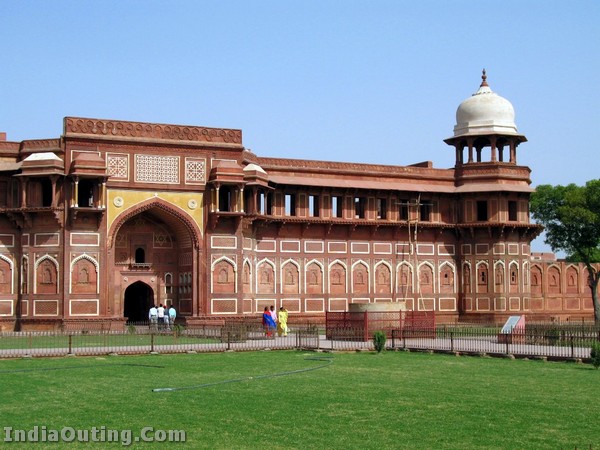

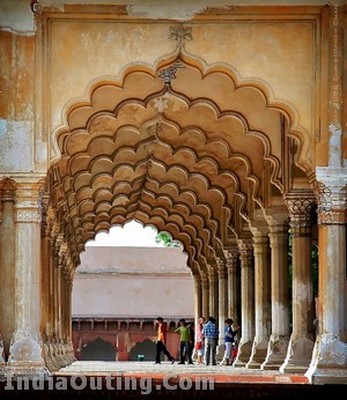
Geography
Agra is situated on the banks of Yamuna river. It has an average elevation of 171 metres (561 ft). On the north it is bound by Mathura, on the south by Dhaulpur, on the east by Firozabad, on the south-east by Fatehabad and on the west by Bharatpur. Agra is the third biggest city in Uttar Pradesh. The Agra district is divided into Six Tehsils and 15 Blocks. Total number of Nayay Panchayats in the district are 114 while Gram Sabhas stands at 636. The total populated villages are 904. The total number of police stations in the district are 41 out of which 16 are in Urban area and 25 are in Rural area. The total number of Railway Stations (including Halts) are 29 and Bus Stands/Bus Stops are 144. Total number of Broad Gauge lines is 196 K.M. and Meter Gauge is 35 K.M.
Climate
Agra, located on the Indo-Gangetic plain has a continental sub-tropical climate, with long, hot summers from April to September when temperatures can reach as high as 45°C (113°F). During summers dry winds (loo) blow in this region. The monsoon months from July to September see about 67 cm (27 inches) of rainfall annually.
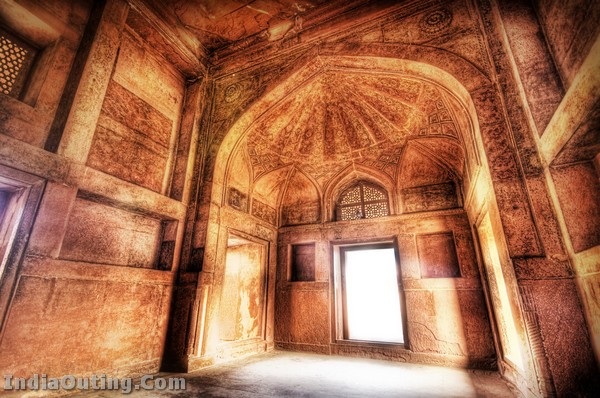
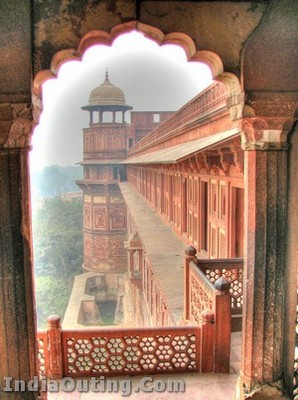

Getting In
By Air
Agra Airport at Kheria is around 6 KM from the city centre, but is not very well connected. It has direct flights only to and fro Delhi. Indira Gandhi International Airport, Delhi is the best option. Agra is very well connected to Delhi both by Rail and Road.
By Rail
Agra is on the main train line between Delhi (Station Code : NDLS) and Mumbai (Bombay) (Station Code : CSTM) and between Delhi and Chennai (Station Code : MAS) and many trains connect Agra with these cities every day. Some east-bound trains from Delhi also travel via Agra, so direct connections to points in Eastern India (including Kolkata) (Calcutta) are also available. There are close to 20 trains to Delhi every day, and at least three or four to both Mumbai and Chennai. There are three stations in Agra:
- Agra Cantt (Station Code : AGC) is the main railway station and lies southwest of the Taj and Agra Fort, both of which are a short ride from the station by car, auto-rickshaw, or cycle rickshaw. There’s a prepaid taxi stand right outside that charges a flat Rs.120 to any hotel in the city. The station has a pretty good Comesum food court that also sells cheap, hygienic takeaway snacks (sandwiches, samosas, etc).
- Agra Fort Railway Station (Station Code : AF) near Agra Fort, is infrequently serviced by the interstate express trains. The station serves trains to the east (Kanpur, Gorakhpur, Kolkata) some of these trains also stop at Agra Cantt.
- Raja Ki Mandi (Station Code : RKM) is a small station. Some of the train which stop at Agra Cantt also stop here. Its a very laid back station and springs into life at the arrival of Intercity Express and Taj Express.
The luxury train – Palace on Wheels also stops at Agra on its eight day round trip of tourist destinations in Rajasthan and Agra.
By Road
Idgah Bus Stand is the biggest Bus Stand in Agra and is connected to most of the bigger cities in North India.
- From Delhi: NH2, a modern divided highway, connects the 200 km distance from Delhi to Agra. The drive is about 4 hours, a large chunk of which includes navigating the clogged roads around Delhi to get to the highway. The primary access to the highway is along Mathura Road in Delhi but, if coming from South Delhi or Delhi Airport, it is easier to take Aurobindo Marg (Mehrauli Road) and then work up to NH2 via Tughlakabad.
- From Jaipur: National Highway 11, a two lane undivided highway, connects Agra with Jaipur via the bird sanctuary town of Bharatpur. The distance of around 255 Km can be covered in around 4 hours.
- From Gwalior A distance of around 120 km, takes around 1.5 hours on the National highway 3, also known as the Agra – Mumbai Highway.
- From Lucknow / Kanpur NH2, the divided modern highway, continues on to Kanpur (285km, 5 hours) and from there to points East ending in Kolkata. From Kanpur, NH25 heads for the city of Lucknow (90 km, 2 hours).
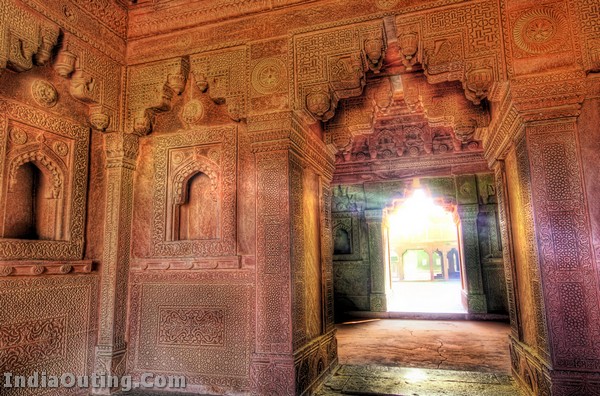
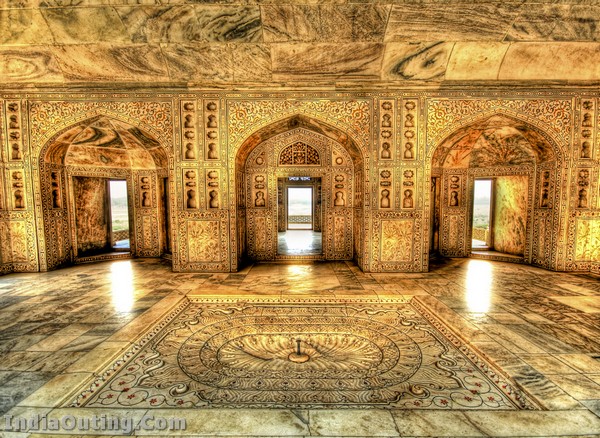
Places of Interest
- Taj Mahal : Agra’s Taj Mahal is one of the most famous buildings in the world, the mausoleum of Shah Jahan’s favorite wife, Mumtaz Mahal. It is one of the New 7 Wonders of the world, and one of three World Heritage Sites in Agra, the others being Agra Fort and Fatehpur Sikri.
- Agra Fort : Another world heritage site in Agra. Agra’s dominant structure, the Agra Fort (sometimes called the Red Fort), was built by Akbar in 1565. Be Noted that a Stone Plate located at the Gate of Fort describes it to be built before 1000 and later renovated by Akbar. The red sandstone fort was renovated and converted into a palace during Shah Jahan’s time, and reworked extensively with marble and pietra dura inlay. Notable buildings in the fort include the Pearl Mosque, the Diwan-e-Am and Diwan-e-Khas (halls of public and private audience), Jehangir’s Palace, Khaas Mahal, Sheesh Mahal (mirrored palace), and Musamman Burj.
- Fatehpur Sikri : The Mughal Emperor Akbar built Fatehpur Sikri about 35 km from Agra, and moved his capital there. Later abandoned, the site displays a number of buildings of significant historical importance. A World Heritage Site, it is often visited by tourists to Agra. The name of the place came after Mughal Emperor Babur defeated Rana Sanga in a battle at a place called Sikri (about 40 km from Agra). Then Mughal Emperor Akbar wanted to make Fatehpur Sikri his head quarters. So he built this majestic fort. But due to shortage of water he had to ultimately move his headquarters to Agra Fort.
- Buland Darwaza : or the loft gateway was built by the great Mughal emperor, Akbar in 1601 CE. at Fatehpur Sikri. Akbar built the Buland Darwaza to commemorate his victory over Gujarat. The Buland Darwaza is approached by 42 steps. The Buland Darwaza is 53.63 m high and 35 meters wide. Buland Darwaza is the highest gateway in the world and an astounding example of the Mughal architecture. The Buland Darwaza or the magnificence gateway is made of red and buff sandstone, decorated by carving and inlaying of white and black marble. An inscription on the central face of the Buland Darwaza throws light on Akbar’s religious broad mindedness, here is an inscription one on the monument which is a message from Jesus advising his followers not to consider this world as their permanent home.

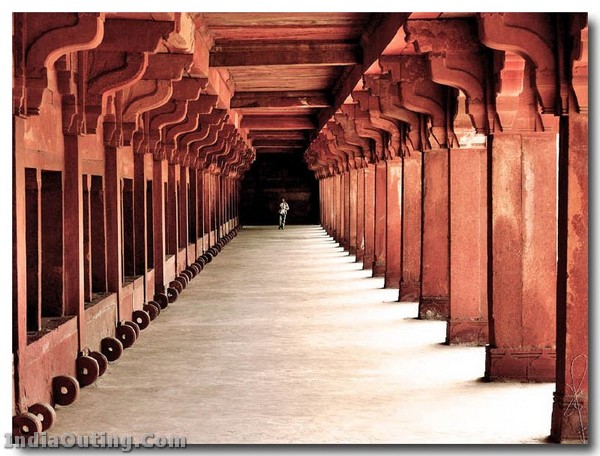
- Itmad-Ud-Daulah : Empress Nur Jehan built Itmad-Ud-Daulah’s Tomb, sometimes called the Baby Taj, for her father, Ghias-ud-Din Beg, the Chief Minister of Emperor Jahangir. Located on the left bank of the Yamuna river, the mausoleum is set in a large cruciform garden criss-crossed by water courses and walkways. The mausoleum itself is set on a base about 50 meters square and about 1 meter high. The mausoleum is about 23 meters square. On each corner are hexagonal towers, about 13 meters tall. Small in comparison to many other Mughal-era tombs, it is sometimes described as a jewel box. Its garden layout and use of white marble, pietra dura, inlay designs and latticework presage many elements of the Taj Mahal.
- Guru ka Tal : Guru ka Tal was originally a reservoir meant to collect and conserve rainwater built in Agra, near Sikandra, during Jehangir’s reign next to the Tomb of Itibar Khan Khwajasara in 1610. In 1970s a gurudwara was erected here. Guru ka Tal is a holy place of worship for the Sikh. Four of the 10 Sikh gurus are said to have paid it a visit. Enjoying both historical and religious importance, this gurudwara attracts number of devotees and tourists. Boasting elaborate stone carvings and 8 towers of the 12 original towers, this gurudwara beckons travelers from far and away to bask in its glory.
- Jama Masjid : The Jama Masjid is a large mosque attributed to Shah Jahan’s daughter, Princess Jahanara Begum, built in 1648, notable for its unusual dome and absence of minarets.
- Chini Ka Rauza : Notable for its Persian influenced dome of blue glazed tiles, the Chini Ka Rauza is dedicated to the Prime Minister of Shah Jahan, Allama Afzel Khal Mullah Shukrullah of Shiraz.
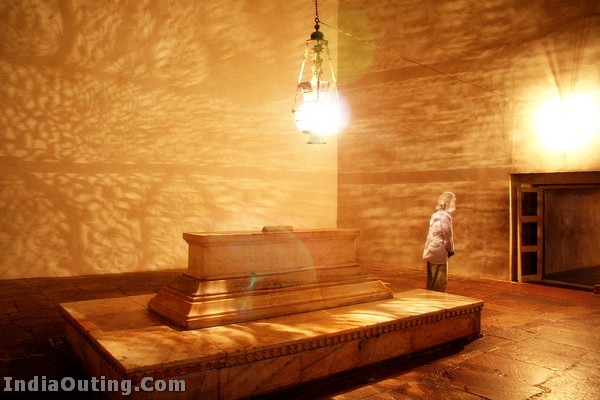
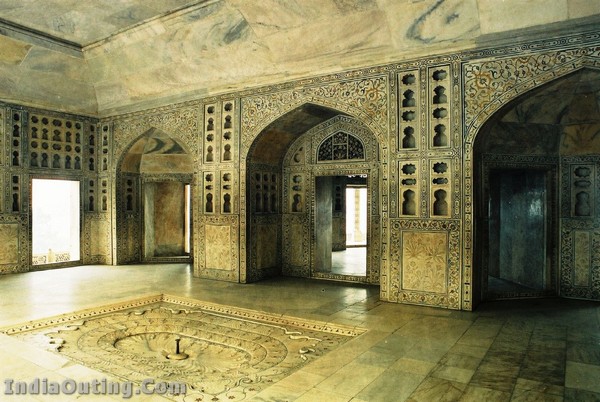
- Ram Bagh : The oldest Mughal garden in India, the Ram Bagh was built by the Emperor Babur in 1528 on Yamuna’s bank. It lies about 2.34 km north of Taj Mahal. The pavilions in this garden are designed in such a manner that the wind from the Yamuna, combined with the greenery, keeps these pavilions cool even during the peak of summer. Aram Bagh is also incorrectly called Ram Bagh by the locals.
- Mariam’s Tomb : Mariams Tomb, is the tomb of Mariam, the wife of great Mughal Emperor Akbar. The tomb is within the compound of Christian Missionary Society.
- Mehtab Bagh : Mehtab Bagh, is on the opposite bank of River Yamuna on which the Taj is present.
- Keetham Lake : Also known as Sur Sarovar, the Keetham Lake is situated at about 23 kilometres from Agra within the Surdas Reserved Forest. The lake has an impressive variety of aquatic life and water birds. The tranquil surroundings present an ideal relaxing place.
- Cathedral of the Immaculate Conception : The Cathedral of the Immaculate Conception is the seat of the Roman Catholic Archdiocese of Agra.
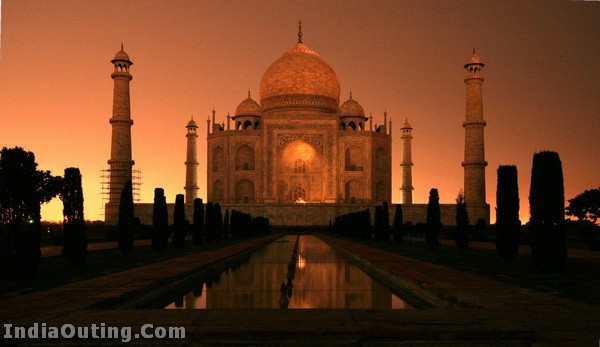
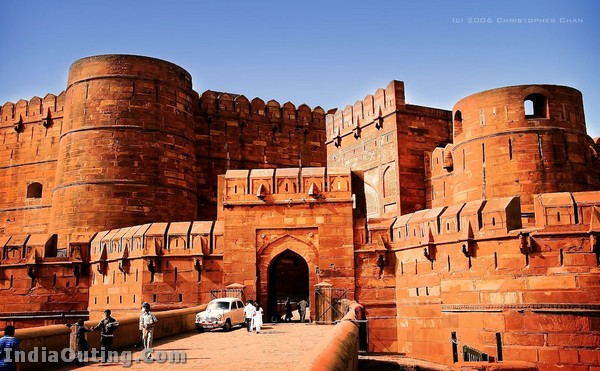


I love it. Beautiful Tajmahal.
One of my wishes is know The Taj Majal;
Is Beautifull, magic, fantastic, historic,Wonderfull…………………
can anybody show the photographs of Dayal Bagh of Agra which is still incomplete but worth seen?
agra is hestorycal city of india . seans muglas period ,the taj is a tample of love .so we called ” heaven of the love”. this tample attach a love story between sahajaha & mumtaj mahal.
i was at Agra for two years and whenever my relations and my friends come to meet me i always visit the Taj mahal and forts and take mny photos and appreciate the costruction,The designs are lovely .
There was some good old stories and it is one of the wonders of the world
PROUD TO BE INDIAN
Truly antique India: TAKE CARE OF IT GUYS…
Ya,
Its a fantastic. Though I had been to Agra, It gave me more information than a visit to Agra. I think, now I should re-visit Agra
Good Information and Congrats
Pradip Shah (Baroda)
can anybody show the photographs of Dayal Bagh of Agra
thats is much and more pleasent and beautiful mahal
its very interesting, I am history student so its very useful for my study thank you, please send these type of mail for me thank you once again
agra is hestorycal city of india . seans muglas period & Ii is very beutiful place in india .
Taj Mahal is so nice . It is time we should clean up Agra and the surrounding of Taj Mahal.
I wonder how tourists from other countries can tolerate the dirty surroundings of Taj Mahal.
From Delhi Railways , which smell of urine, till Kanyakumari we need to clean up and batel ( red color) spitting on the streets should be banned.
We cant make beautiful taj but can clean up the streets……………
love may happen after seeing the importance of taj structures
that is the magic of love
from love (Siraj)
indian taj
wha taj
taj is beautyful
i am bhi beautyful
its my pleasure to say that how beautiful the pictures are i really enjoyed it.
TAJ IS VERY NICE BECOUSE THISE IS A SYMBOL OF LOVE I THINK………….. EAST OF WEST TAJ IS THE BEST………I LOVE TAJ
very nice. thanks
good day to you
Heard Taj a lot of times but never gets time to visit
oh god
please please take me to agra
i can not resist any more .
2009 should be the year for me to visit Taj to feel that beauty of love
indian taj
wha taj
taj is beautyful
i am bhi beautyful
I really like it.
its a great city of taj mahel.
i love it very much b’coz its a sign of indian love.
taj mahal is a seven wonderers in the world
taj is a beautiful and gorjious
We r verymuch lky to have a Monument of Taj Mahal,but i am unlky that i have not seen it till date.Proud to be an INDIAN.
agra is a very beautiful place to visit
i had been there, trully beautiful place.
I like very much this images and informations.
Eternal building
One of my dreem is to see the beautiful tajmahal one day.
i just wanna say the another mean of TAJi s LOVE LOVE LOVE
taj is beauty
Taj Mahal is a beautiful monument.
we were there last nov. 24. the taj mahal is truly one of the wonders of the world. its a work of art to its limit. an amazing architecture. hope it can be preserved to last for a lifetime.
THIS IS ABEATIFUL STRUCTURE. PLEASENT & HISTORIC.SYMBOL OF LOVE.
RAJABABU.KAPPALA
RYALI
HIIIIIIIIIIIII VERY NICE
Hi……..
Taj Mahal is very beautiful and good for tour
I want to visit there…
very nice pics of Taj Mahal
There is no meaning in yelling ou ‘wonder of the world’ unless the nasty surroundings are cleaned up. It smells so badly, vomitting and no toilet facilities …nothing. Many foreigners visit and they are not able to stand for a long time because of no proper sanitary facilities. Indians, used to urinate or shit anywhere as usual. Long Live Taj!
i love taj mahal because that is to goooood i want to visit their
feel that lovers who made the taj mahal great lovers shahjaha and mumtaz every one remember that copule that is turth lovers every on salute from (salman)
any body love do like that all are remembers u blessing for every one take care spl for lovers From (salman )
I LOVE IT……… THANK U………
superb…………..i donot talk about it ……………….because it is very very much beautiful
I Love Taj Mahal very much.
It is marvellous, God’s creation and architech skill is no words to express
Taj mahal is very very beautiful, It is one of the best memorial place for the love
Please place the picture of Taj mahal full view at day clear picture
TAJ MAHAL IS VERY VERY BEAUTIFUL
want to visit such a remarkable place. only need is money. better see by net photographs.really spellbinding.
its a unique and passionate symbol of love..i love it..its so beautifulllll
”LOVE” meen this Taj Mahal
i love it……..
NO WONDER THAT IT IS ONE OF THE SEVEN WONDERS IN THE WORLDDDDDDD
I long to visit this place like anything.It is next to heaven for me.
meri janam bumi hey agra mera bachpane bitha agra mein.kitne sal ho gaye agra gaye, mein jaha bhey rahyo agra nayie bhul sakti. sat samundhar par bhey agra ki mitti ki gushbu dil mey basi huey hey, agra i love youuuuuuuuuuuuuuuuuuuuuuuuuuuuuuuuuuuuuuu
very very nice photograph and very nice contant.
Dear Team ,
thanks…………
please send me as soon as possible
Regards,
Santosh Panchal
Tajmahal is a symbol of love.
Tajmahal is a soul of lover.
Tajmahal is a role model of lovers.
It is n’t Craver. It is one person soul
some one tell this is just craver. Not like this is really two person heart.
Now a day i won’t see tajmahal.
But i like very much. why means two person real love. In these culture not seen real love. that why i seen that.
thanking you.
ITS BEAUTIFULL
very very very very nice photo we enjoy the it
i feel very super
wow….
mumtaj..u r peace of love….
My Heartiest Place…..
very very nice photograph and very nice contant.
WOW MUMTAJ WAS A PEACE OF LOVE WITH SHAHJAHAN
like
i love Taj
it’s a sign of love.
i visited Agra once… Tajmahal is Beautiful
i love love so i love tajmahal………